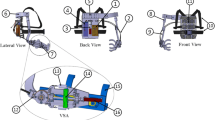Abstract
An elbow orthosis with pneumatic artificial muscles has been developed to assist and enhance upper limbs movements and has been examined for effectiveness. The effectiveness of the elbow orthosis was examined by comparing muscular activities during alternate dumbbell curl motion wearing and without wearing the orthosis. The subjects participating in the experiment were young adults in their twenties. The subjects were instructed to perform a dumbbell curl motion in a sitting position with and without wearing an orthosis in turn, and a dynamometer was used to measure elbow joint torque in isokinetic mode. The measurements were done with four various dumbbell loads: 0, 1, 3, and 5 kg. We examined the effectiveness of the elbow orthosis in two control methods. First, the orthosis was pneumatically actuated and controlled in the passive control mode. Then, it was controlled in the active control mode using the muscular stiffness force of the muscle that is measured from a force sensor through a cDAQ-9172 board. For the analysis of muscular power, the muscular activities of the subject were measured during alternate dumbbell curl motion using MP150 (BIOPAC Systems, Inc.). The muscles of interest were biceps brachii muscle, triceps brachii muscle, brachioradialis muscle, and flexor carpi ulnaris muscle in the upper limbs of the right side. The elbow joint torque was measured during elbow flexion motion using a dynamometer at 60° per second for isokinetic strength. The experimental result showed that the muscular activities wearing the elbow orthosis were reduced and elbow joint torque wearing the elbow orthosis was higher because of the assist of the orthosis. As a result of this experiment, the effectiveness of the developed elbow orthosis was confirmed and the level of assistance was quantified. With this, we confirmed the effectiveness of the developed elbow orthosis.
Similar content being viewed by others
References
J. M. Hollerbach, Some current issues in haptics research, Proc. IEEE International Conference on Robotics and Automation, San Francisco, California, USA (2000) 757–762.
M. Bergamasco, B. Allotta, L. Bosio, L. Rerretti, G. Parrini, G. M. Prisco, R. Salsedo and G. Sartini, An arm exoskeleton system for teleoperation and virtual environments applications, Proc. IEEE International Conference on Robotics and Automation, Sen Diego, CA, USA (1994) 1449–1454.
R. Jacob, B. Moshe, B. Moshe, Fuchs and A. Mircea, A myosignal-based powered exoskeleton system, IEEE Transactions on systems, Man, and Cybernetics-part A: Systems and humans, 31(3) (2001) 210–222.
K. Kiguchi, S. Kariya, K. Watanabe and T. Fukuda, Application of multiple fuzzy-neuron controllers of an exoskeletal robot for human elbow motion support, Transactions on Control, Automation, and Systems Engineering, 4(1) (2002) 49–55.
J. H. Hong, Physical restoring and recovering technology for the elderly, Journal of the Korean Society of Precision Engineering, 21(1) (2004) 17–25.
T. Tsuruga, S. Ino, T. Ifukube, M. Sato, T. Tanaka, T. Izumi and M. Muro, A basic study for a robotic transfer aid system based on human motion analysis, Advanced Robotics, 14(7) (2000) 579–596.
P. Daniel, Rerris, M. Joseph, Czerniecki and B. Hannaford, An ankle-foot orthosis powered by artificial pneumatic muscles, J. Appl. Biomech., 21(2) (2005) 189–197.
H. Kobayashi and H. Suzuki, A muscle suit for the upper body development of a new shoulder mechanism, 2005 IEEE Workshop on Advanced Robotics and its Social Impacts (2005) 149–154.
H. Imai, M. Nozawa, Y. Kawamura and Y. Sankai, Human motion oriented control method for humanoid robot, Proc. 11th IEEE International Workshop on Robot and Human Interactive Communication(ROMAN 2002), Berlin, Germany (2002) 221–226.
Kawamoto and W. Sankai, Power assist method based on phase sequence driven by interaction between human and robot suit, Proc. the 2004 IEEE international Workshop on Robot and Human Interactive Communication, Kurashiki, Okayama, Japan (2004) 491–496.
K. Yamamoto, M. Ishii, H. Noborisaka and K. Hyodo, Stand alone wearable power assisting suit sensing and control systems, Proc. IEEE international Workshop on Robot and Human Interactive Communication, Kurashiki, Okayama, Japan (2004) 661–666.
K. Kim, T. K. Kwon, S. R. Kang, Y. J. Piao and G. Y. Jeong, Evaluation of Plantarflexion Torque of the Ankle-Foot Orthosis Using the Artificial Pneumatic Muscle, Journal of the Korean Society for Precision Engineering, 27(6) (2010) 82–89.
S. Moromugi, Y. Koujina, S. Ariki, A. Okamoto, T. Takayuki, M. Feng, T. Ishimatsu, Muscle stiffness sensor to control an assistance device for the disabled, Artificial Life and Robotics, 8(1) (2004) 42–45.
Y. K. Kim, H. J. Lee and J. G. Jung, The influences of isokinetic exercise during short time on the variation of muscular function and the level of muscular enzyme, The Korean Journal of Exercise Nutrition, 5(2) (2001) 93–102.
C. H. Lee, J. U. Heo, C. S. Kim and G. M. Eom, Identification of spastic joint pathologies using isokinetic movement, The Korea Society for Emotion & Sensibility, 7(4) (2004) 19–24.
Author information
Authors and Affiliations
Corresponding author
Additional information
This paper was recommended for publication in revised form by Associate Editor Sungsoo Rhim
Kyung Kim received his B.S, M.S and Ph.D in Biomedical Engineering from Chonbuk National University, South Korea, in 2003, 2005 and 2010, respectively. His research interests include rehabilitation engineering and biomechatronics.
Kyung-Ju Hong received her M.S in Biomedical Engineering from Chonbuk National University, South Korea, in 2007. Her research interests include rehabilitation engineering and biomechatronics.
Nam-Gyun Kim received his Ph.D from the University of Strasbourg in 1987. Dr. Kim’s research interests include postural control, rehabilitation engineering.
Tae-Kyu Kwon received his Ph.D from Tohoku University, Japan, in 1999. Prof. Kwon’s research interests include rehabilitation engineering, biomechatronics.
Rights and permissions
About this article
Cite this article
Kim, K., Hong, KJ., Kim, NG. et al. Assistance of the elbow flexion motion on the active elbow orthosis using muscular stiffness force feedback. J Mech Sci Technol 25, 3195–3203 (2011). https://doi.org/10.1007/s12206-011-0923-9
Received:
Revised:
Accepted:
Published:
Issue Date:
DOI: https://doi.org/10.1007/s12206-011-0923-9




